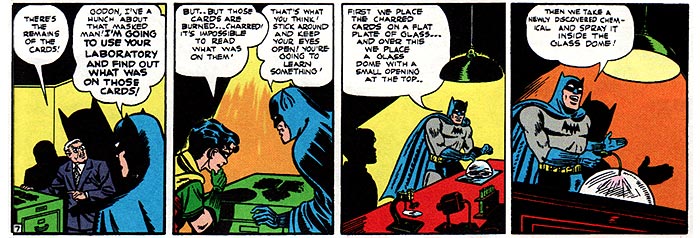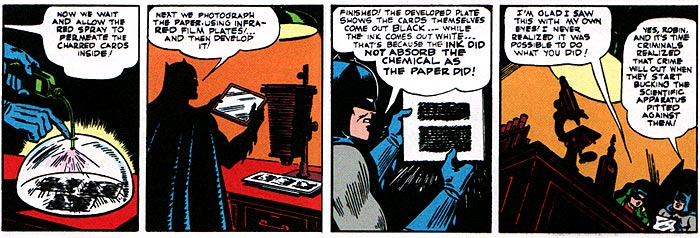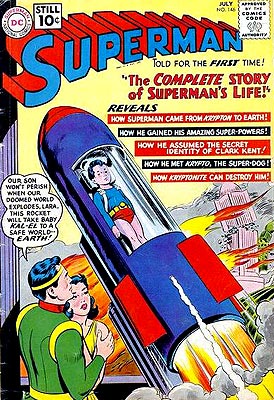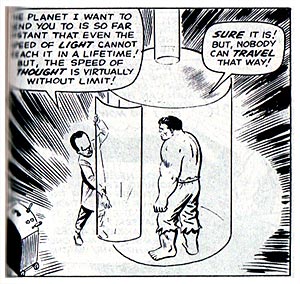Showing 21 - 30 of 39 posts found matching keyword: science
Tuesday 1 December 2009
The 2009 W.A.T.C.H. list of dangerous toys is out. This year amid such life-threatening fare as Lots to Love Babies and Curious Baby Curious George Counting - My First Book of Numbers lurks none other than the Wolverine! World Against Toys Causing Harm warns that X-Men Origins Slashin' Action Wolverine presents the "POTENTIAL FOR EYE AND AND OTHER IMPACT INJURIES!" (Their capitalization, not mine. My Caps Lock key works just fine, thank you.) Well, duh. After all, Wolverine is the best there is at what he does, and what he does is not cuddling. He is genetically designed always to be running with scissors, for Pete's Sake, hardly a proper role model for little Jack and Jill. The figure's packaging brags that Wolverine is an "indestructible combat machine," which sounds about right (and, despite W.A.T.C.H.'s criticism that the toy packaging contains no caution label, qualifies as all the warning any eye impact injury-free parent should need). Giving Wolverine to a toddler is equivalent to giving him a plugged in toaster filled with forks. I don't see that on your list, W.A.T.C.H.
Now if you'll excuse me, I think I'd like to buy that Spy-Gear Viper-Blaster that W.A.T.C.H. discourages. Because a gun that shoots snakes sounds like something Santa will be giving Toys For Tots this year.
Comments (0) | Leave a Comment | Tags: holidays science toys
Wednesday 21 October 2009
CSI: Gotham City.


This process is called infrared luminescence photography and is still in use today. These days scientists rarely need to use any "newly discovered chemical" because of advancements in infrared imaging, still a relatively new and delicate process in the 1930s.
Thank you, Batman, for putting me one step closer to the perfect crime.
Comments (0) | Leave a Comment | Tags: batman comic books history science
Wednesday 26 August 2009
Last night Katie Couric told me that U.S. Government studies reveal that the general public is skeptical of the need for a new flu vaccine. Among the concerns specifically included in her over-simplified info-graphic were the following three points:
- people believe that the H1N1 virus is a "mild disease overblown by media";
- the potentially dangerous "new vaccine developed too quickly";
- and the standby "parent's fear for children's safety"
Putting aside the fact that the media informed me about the public's distrust of the media (curse you, CBS, for making me doubt that I doubt you!), this made me wonder: what does America trust anymore?
Point 1: Clearly it's not the media. They've enjoyed exaggerating the dangers of a flu virus variant that has almost exactly the same death rate as the standard flu. But wait, the media cries! This flu tends to kill the young instead of the elderly, the inverse of a typical flu virus, so be afraid! The media enjoys reporting the difference in ages as "years of lives lost", meaning that this virus kills more potential years than most preceding flu viruses. (I'm not making that up; I read it in Time magazine). That would make this the worst hypothetical danger ever besides perhaps the Death Star or the year 2012. Also, you'd best not take into account perennial potential-stealers such as SIDS, which has killed more babies than this new flu virus has killed humans over the same time span. So maybe this distrust in the media is valid.
Point 2: Clearly it's not the government. Big Brother Obama wants the vaccine deployed yesterday. Earlier this week, the White House "advised" the Department of Health and Human Services (HHS) to accelerate vaccine availability. HHS is the umbrella agency which provides oversight for the CDC, FDA, and NIH. And of course when the White House says jump, all Cabinet members, including the Secretary of the HHS, has to say how high or risk losing their jobs. So should people have concerns that the political expediency needs of the White House would cause the HHS to rush the production of a potentially dangerous vaccine before the appropriate alphabet agencies have had a chance to verify that it is safe? Yes, they should. (See President Ford's ill-fated 1976 mass inoculation program against swine flu for details.)
Point 3: Clearly it's not reason. Parents are so afraid of the side-effects of a vaccine of weakened virus that they'll run the risk of exposing their children to a strong, baby-killing flu virus instead? Do these same parents wrap their children in suits of padded bubble wrap? Cover their mouths and noses with tape to keep out smog and allergens? Keep them locked in the basement to avoid falling down stairways and being exposed to carcinogenic sunshine? Clearly God sends disease to punish us, so who are we to try and oppose his will? Who wants to live in a world where our entertainment outlets and elected government alike are out to kill us, anyway?
The cure may be worse than the disease, but I doubt that either is worse than the symptoms.
Comments (0) | Leave a Comment | Tags: news politics science
Monday 20 July 2009
It was 40 years ago today that man first landed on the moon. Now the generation that supported that amazing scientific achievement is more concerned with universal health care than they are with exploring the universe.
I suspect that I will not see a man on the moon in my lifetime. Even though it was essentially accomplished in a decade the first time around, it took a drive that seems to be completely lacking in the post-Cold War era. Say what you will about competition, but it gets things done. (Yes, I'm talking to you, socialists!)
I suppose I'll have to content myself with cheering for machines that are designed to do a man's job, such as the Mars rovers Spirit and Opportunity, each of which continues to do a stellar job of investigating an alien environment over 5 years after their original mission was scheduled to end. Certainly no human would be willing to do that.
Comments (0) | Leave a Comment | Tags: history science space
Friday 17 July 2009
Despite the study having been published months ago in Social Science Quarterly, it has just been brought to my attention that my name marks me as someone "more likely to engage in criminal activity" than the average boy. At least if I were a juvenile native to Pennsylvania, where the study was conducted by Shippensburg University faculty.
What this means is that the ratio between the number of juveniles in the state who share my name and the number of those juveniles who are officially considered "delinquents" is abnormally high. The study's conclusion is not that certain names make for inherently bad people, but that families predisposed to certain socioeconomic conditions are more likely to name their children certain names. In other words, I'm not bad, my family is.
Throw in the fact that the maternal half of my family which is partial to the name "Walter" is also fond of "Alec," another of the study's 10 worst names, and you can begin to get a sense of where my family may be headed. My mother's sister recently nicknamed a dog "Luke," yet another of the 10 worst names, but I'm not sure that this really counts because it's a nickname for "Lucifer," which definitely was not on the list.
For the record, the names are Alec, Ernest, Garland, Ivan (my favorite: I always knew Ivan was trouble), Kareem, Luke, Malcolm, Preston, Tyrell and Walter. That's alphabetical order, not most troublesome.
Comments (0) | Leave a Comment | Tags: news science walter
Friday 5 June 2009
I'm sure it's been said before, but it bears repeating that the scientists on Krypton weren't very bright. From a race with "powers and abilities far beyond those of mortal men," only one scientist realized that the planet was dying from an unstable and radioactive core malfunction. And it's rather ironic that the one scientist who was concerned about the destruction of his home world, Jor-El, had previously invented a device to transfer people to another dimension, the Phantom Zone Projector, and promptly used that amazing device to fill the newly discovered dimension with criminals. (Oops. Even for superior Kryptonian physiology, hindsight is 20-20, I suppose.)
Following the Kryptonian-ruling Science Council's refutation of Jor-El's theory of Krypton's impending destruction (which had been unwisely published in the Krypton Journal of Mad Science) and refusing to escape into a prison of his own design, Jor-El focused his efforts on building rockets to save the population of Krypton. Up to this time, advanced Kryptonian scientists had concentrated on building flying cars, humanoid robots with advanced artificial intelligence, interdimensional travel, inter-planetary nuclear missiles, and interstellar space probes, but no member of their advanced society had endeavored to create a means by which a Kryptonian could escape Krypton. Unless, of course, you count the city of Kandor's interaction with interstellar travelers such as Braniac, Jor-El's relatives who discovered alternate dimensions similar to the Phantom Zone such as the Survival Zone, Argo City's orbital domed habitat, or even the Kryptonians who used rockets to flee Krypton and settle the planet Daxam. Yet the noble Jor-El eschewed the work of other, lesser scientists, and designed his own rocket that was, um, better and, um, different than those that had gone before.

Jor-El theorized that the entire population of Krypton could be relocated to the planet Earth, where Kryptonians would have powers like gods. Like all good scientists, he built his rocket in miniature and ran tests. (World coming to an end? Don't rush out and build a full-sized rocket, Dr. Zarkov. You can't violate your prime directive: the Scientific Method must be maintained or survival means nothing!) In his first test, Jor-El launched the family dog into space. That rocket got lost, but no worries; the experience only proved how right he was to run tests. Jor-El followed this with a more successful trial of a rocket piloted by the family monkey. (An inadvertent side-effect of this trial was that the monkey immediately developed a lust for space travel and would as a result survive the destruction of Krypton. Beware the runaway space monkey!) However, before Jor-El could build a full-sized rocket for himself and his lovely wife Lara, in a moment of panic Lara stuffed their newborn son into the test rocket and launched it into space. Kryptonians didn't have pets or children; they had test subjects.
And so it is fitting that the son of Krypton's most esteemed scientist, Jor-El, and the only survivor of the destruction of the science-obsessed planet of Krypton (not counting those aforementioned Kandorans, Phantom/Survival Zone Kryptonians, Argoans, Daxamites, or lone monkey) has become renowned for solving problems not through scientific investigation and methodical trial, but with his fists. "Truth, Justice, and the American Way" sounds great, but it doesn't mean much if you can't back it up with a good right hook.
Comments (0) | Leave a Comment | Tags: comic books science superman
Thursday 30 April 2009
I don't know if you've heard yet, but we're all going to die. Swine flu is going to kill us all. So says all the important talking heads on television, radio, and the internet. And they've never led us astray.
Dr. Margaret Chan, Director-General of the World Health Organization, has said that "it is really all of humanity that is under threat of a pandemic." Don't be fooled by the fact that "pandemic" simply means "global distribution of the disease." AIDS is a pandemic, and unless you're Magic Johnson, it's fatal, remember? So straight from the mouth of Dr. WHO, this flu is clearly something to be feared.
Responding to the dire news, 3M has announced that that they're ramping up production of respiratory masks to meet the consumer demand swelling before the onslaught of this modern plague. Never mind that the Center for Disease Control does not recommend the use of respirator masks for preventing the spread of this particular strain of flu as unnecessary. Why listen to the CDC, anyway? They're a government agency, so of course they don't have our best interest at heart. How else are we going to contain our sneezes? They don't expect us to use our

News reports indicate that since the initial outbreak of the disease a month ago, Mexico officially "suspects" that the swine flu has killed 159 Mexicans out of over 3,000 suspected cases. That's a mortality rate greater than 5%, ten times greater than the standard death rate for the .003% of the Mexican population that has had the flu! The argumentative WHO claims that they've only counted 7 deaths in 79 confirmed cases worldwide, nearly doubling Mexico's estimated mortality rate to a staggering 9% of the nearly .000001% of the world population that has contracted the virus! In either case, if left unchecked at it's current rates, this flu could sweep across the face of the globe, killing literally thousands of the 7 billion world population! Oh, the humanity!
So make peace with your gods, people. The end isn't near, it's already here. And it smells like bacon.
Comments (0) | Leave a Comment | Tags: news science superman
Friday 5 December 2008
I know the Hulk is a few cucumbers short of a salad, but I'd certainly expect the Leader to know better.

"Without limit"? The speed of light is 186,000 miles per second. The speed at which electrical impulses travel along the brain's neurons tops out at .075 miles per second when you're drinking Red Bull. Therefore it would take a month for a thought to travel as far as light does in one second.
But what should I expect from two fellows who think that bathing in highly-lethal gamma radition is a sure path to fun and profit? No doubt, the Leader also thinks he uses the "unused" 90% of his brain that the averge human doesn't and that if he sneezed with his eyes open, they would pop out of his head.
Comments (0) | Leave a Comment | Tags: comic books hulk science
Friday 10 October 2008
Today was supposed to be the end of the world. So if you're reading this, we must all be dead.

A lot of furor was made this summer over the activation of the Large Hadron Collider (LHC) in Switzerland. The LHC is a $6 billion chemistry set designed to replicate the natural collision between sub-atomic particles at near the speed of light in order to substantiate the existence of theoretical particles of matter. Try doing that in your garage!
However, some grizzled curmudgeons have complained that the replication of the natural collision of particles could result in black holes that will rend the Earth atwain! But who ever listens to the town drunk who warns us not to go down to the lake? At least these complainers are smart enough not to make the more logical complaint that Switzerland has built something the size of a city to explore a purely academic scientific pursuit instead of throwing that $6 billion at something more practical, such as clean coal, hydrogen fuel cells, or growing hamburgers on trees. It's the more sensational fear of the apocalypse that grabs headlines, not simple whining about political boondoggles.
This morning, it turns out that sucking sound you hear is really just the implosion of the U.S. economy. Fortunately for all of mankind, the LHC sprung a leak (meaning that it could no longer contain those black-hole spawning particles) and was shut down last month, long before it could reach the tests scheduled for today that would end the world. Those Earth-destroying tests have been rescheduled for next year.
I don't know about the rest of you, but I for one am pleased that we have several more months until an artificial black hole births a rampaging energy being that threatens to destroy the Earth, as depicted in the Sci-Fi Channel documentary The Black Hole. Even though scientist Judd Nelson will no doubt arrive to save the day, I'm already constructing a rocket ship to blast my newborn son to a distant planet where, in comparison to the primitive men that populate that planet and aided by the world's white sun, he will have powers and abilities far beyond those of mortal men.
Comments (0) | Leave a Comment | Tags: economy lhc movies science
Tuesday 7 October 2008
The same day I discovered how much spam I was receiving (see previous post for details), I watched the 1973 Michael Crichton-written film Westworld in which the attractions in a lavish theme park inexplicably become murderous. (Really, it's exactly the same movie as the 1993 Michael Crichton-written film Jurassic Park but with less explanation for why the attractions are killing people.) Perhaps it's because I had already been looking at numbers that afternoon, but I became captivated by the economics of Westworld.
The park guests attending the theme park Delos (of which Westworld is just one part, like Frontierland or Adventureland at Walt Disney World Resort) each pay $1,000 per day for a week-long visit to the theme park of their imagination. So for a mere $7,000, these guests spend a week surrounded mostly by robots who simulate the lifestyles, behaviors, and mores of inhabitants of the mythical American West. While that may seem expensive for simple park admission, think about it this way: for $7,000 they get to abuse, kill, or sexually molest machines, who for all practical purposes, are human beings. Says one fellow in a promotional video at the beginning of the movie, "I shot six people!" When you look at it that way, the price of admission becomes a bargain when you consider that the costs of the same actions outside of theme parks is likely life in prison or worse.
It's worth noting here that the Grecian island of Delos was once sacred to the ancient Athenian civilization. Besides being the birthplace of Apollo and Artemis -- god and goddess of arts and the hunt, respectively -- Delos was also famed as a location upon which people were forbidden to be born or die. Quite fitting for a theme park populated by robots. And a way better name than Six Flags.
But more to the point, there are approximately 20 guests seen delivered to Delos by hovercraft for their weekly stay. (Apparently, even in 1973, monorails were artifacts. And to be fair, an actual count appears to be 18 people, but I'm rounding up, figuring in Delos' favor that this was an off-week as they appear to have a slightly greater capacity than they are using.) That means that the gross weekly income at Delos was $140,000, or over $7 million per year generated by 1040 guests, assuming there is no "off" season.
Delos is a very large enterprise, consisting of three "worlds," each populated by dozens of unique and technologically-advanced robots, period-accurate buildings and an underground central command and control complex coordinating the entire site's operations. Weekly expenditures for power and maintenance of such amazing facilities and mechanical marvels would have to be staggering, well exceeding $140,000! (Walt Disney World doesn't release operating costs, but they recently bragged that an energy overhaul saved them 100 million kilowatt hours of electricity per year. At the average Florida commercial price of 10 cents per kwh, that's a monthly savings of well over $800,000!)
To compare, Walt Disney World, opened in 1971, is a huge operation maintained not by expensive robots but by teenagers dressed as "cast members." Well more than 10 millions visitors pass through the Walt Disney World gates every year, 10,000 times greater attendance than Delos achieves! A well-to-do modern day visitor to Walt Disney World could pay well over $5,000 for park admission, room, and food for a week, all of which are included in the admission price to Delos. Transform that $5,000 in modern cash to 1973 dollars, and you find that it's roughly equivalent to... $1,000. Just think about how much red ink there must be on Delos' books!
While having your rides assassinate all of your guests and staff is certainly bad for business, it's probably a better option than actually letting your guests shoot holes in your rides. I'm certainly no business major, but I'm pretty sure that Business 101 includes the maxim that if you construct one-of-a-kind replicas of famed Western actor Yul Brenner, don't let your customers destroy them for a mere $1,000 a day. After all, also in 1973, the United States Government spent six million dollars upgrading just one man! And that was only 2 legs and an arm!
Comments (0) | Leave a Comment | Tags: disney economy history movies science westworld

